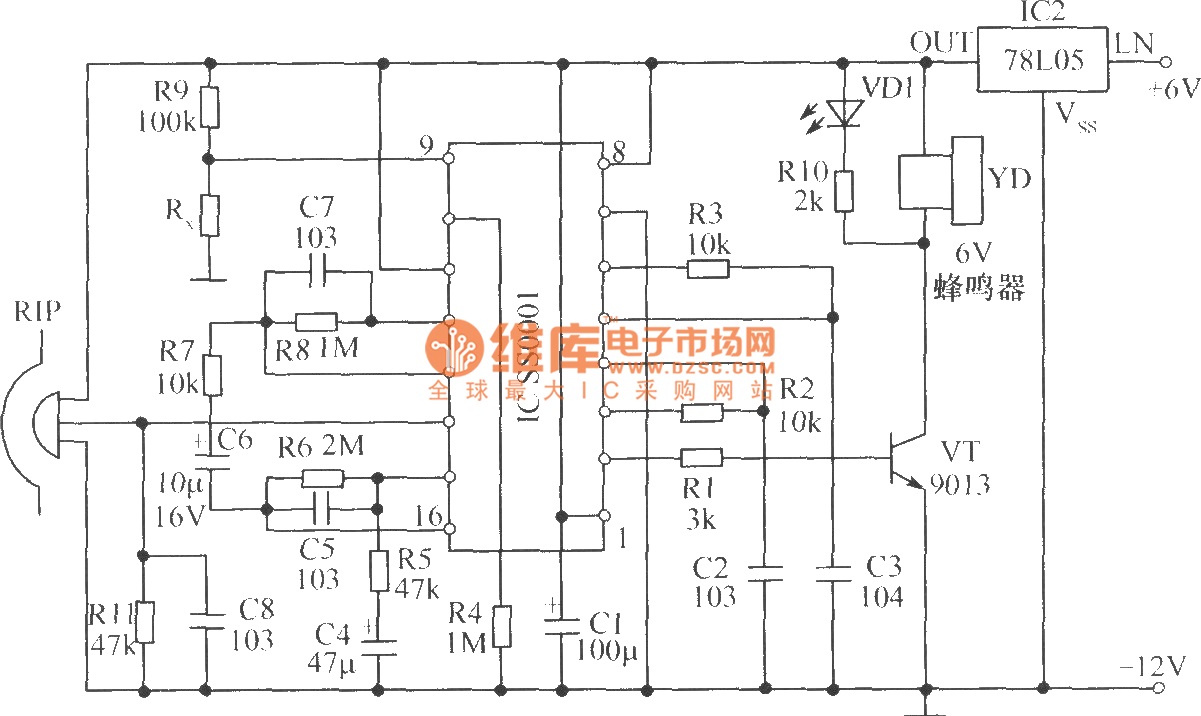
Miniature Loop Alarm

A few months ago, a compact and effective alarm was designed with the following requirements: simple construction, reliable operation, low power consumption, and a small size. Initially, CMOS logic gates were considered, but this approach was abandoned due to complexity. The solution was found in a simple transistor switch configuration. The circuit is straightforward, comprising two identical transistor switches, each connected to its own alarm LED and linked to an 82dB buzzer. To prevent one sensor's signal from triggering both LEDs, two 1N4148 diodes are incorporated. The sensors utilized can be wire loops, normally closed reed switches, or a combination of both. For instance, a wire loop can be attached to a suitcase, while a reed switch can be placed on a hotel room door. Since the alarm is designed for immediate accessibility, there is no automatic shutdown feature; the buzzer will continue sounding until the circuit is turned off or the wire loop is reconnected. Each LED indicates its respective zone. The construction process is straightforward, with no significant challenges for beginners. The inclusion of two 100n capacitors is optional, serving only to mitigate noise interference from the long wire loops. Suitable transistors include any NPN general-purpose audio amplifiers or switches, such as BC 107/108/109, BC 237/238, 2N2222, or 2N3904. The circuit can be assembled on perf board, and alongside the buzzer and a 9V battery, it can fit into a pocket-sized plastic enclosure smaller than a pack of cigarettes. A fresh battery can provide weeks of continuous operation.
The schematic for this alarm circuit illustrates a simple yet effective design that utilizes basic electronic components to achieve its functionality. At the core of the design are two NPN transistors, which serve as switches for the alarm system. Each transistor is responsible for activating its corresponding LED and the buzzer when the appropriate sensor is triggered. The sensors, which can be configured as wire loops or normally closed reed switches, provide flexibility in installation and use.
The use of 1N4148 diodes is critical in this design, as they ensure that the activation of one sensor does not inadvertently trigger the other LED. This feature enhances the reliability of the alarm system, allowing for localized alerts based on the specific sensor that is activated. The alarm's design does not incorporate an automatic shutdown mechanism, which is a deliberate choice to ensure that the user is alerted continuously until they manually disable the system. This aspect is particularly useful in scenarios where immediate attention is required.
The capacitors included in the circuit serve a dual purpose; while they are not strictly necessary for the operation of the alarm, they help to filter out any potential noise that could affect the performance of the long wire loops. This consideration is particularly important in environments where electromagnetic interference might be present.
The choice of transistors is flexible, allowing for the use of various NPN types that are readily available and suitable for low-power applications. The assembly on perf board allows for a compact and efficient layout, making it easy to integrate all components into a small plastic enclosure. This design approach not only meets the size requirements but also ensures that the alarm remains portable and user-friendly.
Overall, this alarm circuit exemplifies a practical application of basic electronic principles, providing an effective solution for security needs with minimal complexity and resource requirements. The ability to operate for weeks on a single 9V battery further enhances its appeal as a reliable and low-maintenance security device.A few months ago, I decided to build a compact, yet effective alarm. My demands were:- simple construction, reliable operation, very small power consumption, and, most of all, small size. I started with CMOS logic gates, but was soon forced to abandon the concept after a few unsuccessful (and far too complicated) attempts.
Then I suddenly realized that a simple transistor switch might do the job and I was right. As you can clearly see from the schematics, the circuit is utterly primitive and consists of two identical transistor switches. Each has its own alarm LED and they`re coupled to a neat 82dB buzzer. The two 1N4148 diodes are used to prevent a signal from one sensor from triggering both LEDs. The sensors used are either wire loops or normally closed reed switches or even a combination of both.
You could, for example, tie a wire loop to your suitcase and place a reed switch to the door of your hotel room. Since this little alarm is intended to be kept in arms reach at all times, there aren`t any provisions for automatic shutdown after a certain period of time.
The buzzer will sound until you turn the whole circuit off or connect the wire loop back to the jumpers. The same goes for the two LEDs, each indicating its own zone. Construction is not critical and there aren`t any traps for the novice. The two 100n capacitors aren`t really necessary, I just included them to make sure that there is no noise interference coming from the long wire loops.
For transistors, you can use any NPN general-purpose audio amplifiers/switches (BC 107/108/109, BC 237/238, 2N2222, 2N3904. ). Assemble the circuit on perf board. Together with the buzzer and a 9V battery, it should easily fit in a pocket-sized plastic box smaller than a pack of cigarettes.
A fresh battery should suffice for weeks of continuous operation. Be the first of your friends to get free diy electronics projects, circuits diagrams, hacks, mods, gadgets & gizmo automatically each time we publish. Your email address & privacy are safe with us ! 🔗 External reference
The schematic for this alarm circuit illustrates a simple yet effective design that utilizes basic electronic components to achieve its functionality. At the core of the design are two NPN transistors, which serve as switches for the alarm system. Each transistor is responsible for activating its corresponding LED and the buzzer when the appropriate sensor is triggered. The sensors, which can be configured as wire loops or normally closed reed switches, provide flexibility in installation and use.
The use of 1N4148 diodes is critical in this design, as they ensure that the activation of one sensor does not inadvertently trigger the other LED. This feature enhances the reliability of the alarm system, allowing for localized alerts based on the specific sensor that is activated. The alarm's design does not incorporate an automatic shutdown mechanism, which is a deliberate choice to ensure that the user is alerted continuously until they manually disable the system. This aspect is particularly useful in scenarios where immediate attention is required.
The capacitors included in the circuit serve a dual purpose; while they are not strictly necessary for the operation of the alarm, they help to filter out any potential noise that could affect the performance of the long wire loops. This consideration is particularly important in environments where electromagnetic interference might be present.
The choice of transistors is flexible, allowing for the use of various NPN types that are readily available and suitable for low-power applications. The assembly on perf board allows for a compact and efficient layout, making it easy to integrate all components into a small plastic enclosure. This design approach not only meets the size requirements but also ensures that the alarm remains portable and user-friendly.
Overall, this alarm circuit exemplifies a practical application of basic electronic principles, providing an effective solution for security needs with minimal complexity and resource requirements. The ability to operate for weeks on a single 9V battery further enhances its appeal as a reliable and low-maintenance security device.A few months ago, I decided to build a compact, yet effective alarm. My demands were:- simple construction, reliable operation, very small power consumption, and, most of all, small size. I started with CMOS logic gates, but was soon forced to abandon the concept after a few unsuccessful (and far too complicated) attempts.
Then I suddenly realized that a simple transistor switch might do the job and I was right. As you can clearly see from the schematics, the circuit is utterly primitive and consists of two identical transistor switches. Each has its own alarm LED and they`re coupled to a neat 82dB buzzer. The two 1N4148 diodes are used to prevent a signal from one sensor from triggering both LEDs. The sensors used are either wire loops or normally closed reed switches or even a combination of both.
You could, for example, tie a wire loop to your suitcase and place a reed switch to the door of your hotel room. Since this little alarm is intended to be kept in arms reach at all times, there aren`t any provisions for automatic shutdown after a certain period of time.
The buzzer will sound until you turn the whole circuit off or connect the wire loop back to the jumpers. The same goes for the two LEDs, each indicating its own zone. Construction is not critical and there aren`t any traps for the novice. The two 100n capacitors aren`t really necessary, I just included them to make sure that there is no noise interference coming from the long wire loops.
For transistors, you can use any NPN general-purpose audio amplifiers/switches (BC 107/108/109, BC 237/238, 2N2222, 2N3904. ). Assemble the circuit on perf board. Together with the buzzer and a 9V battery, it should easily fit in a pocket-sized plastic box smaller than a pack of cigarettes.
A fresh battery should suffice for weeks of continuous operation. Be the first of your friends to get free diy electronics projects, circuits diagrams, hacks, mods, gadgets & gizmo automatically each time we publish. Your email address & privacy are safe with us ! 🔗 External reference





